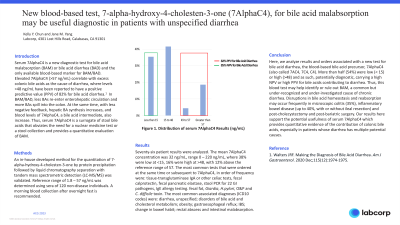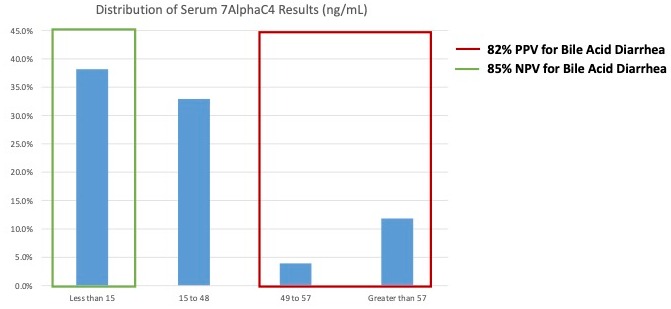Tuesday Poster Session
Category: Functional Bowel Disease
P3362 - New Blood-Based Test, 7-Alpha-Hydroxy-4-Cholesten-3-One, for Bile Acid Malabsorption May Be Useful Diagnostic in Patients With Unspecified Diarrhea
Tuesday, October 24, 2023
10:30 AM - 4:00 PM PT
Location: Exhibit Hall

Has Audio
- JY
Jane M. Yang, MD
Labcorp
Calabasas, CA
Presenting Author(s)
Jane M. Yang, MD, Kelly Chun, PhD
Labcorp, Calabasas, CA
Introduction: Serum 7AlphaC4 is a new diagnostic test for bile acid malabsorption (BAM) or bile acid diarrhea (BAD) and the only available blood-based marker for BAM/BAD. Elevated 7AlphaC4 ( >57 ng/mL) correlates with excess colonic bile acids as the cause of diarrhea, where >48 ng/mL has a reported positive predictive value (PPV) of 82% for BAM/BAD.1 In BAM, less BAs re-enter enterohepatic circulation and more BAs spill into the colon. At the same time, hepatic BA synthesis increases, and blood levels of 7AlphaC4, a bile acid intermediate, also increase. Thus, serum 7AlphaC4 is a surrogate of stool bile acids that obviates the need for a nuclear medicine test or a stool collection.
Methods: Analysis of 76 clinical samples submitted for 7AlphaC4 was performed using a lab developed test (LDT) for 7-alpha-hydroxy-4-cholesten-3-one by protein precipitation followed by liquid chromatography with tandem mass spectrometric detection (LC-MS/MS).
Results: Serum samples from 76 patients had a mean 7AlphaC4 of 32 ng/mL, range 0 – 220 ng/mL, where 38% were low at < 15, 16% were high at >48, with 12% above the reference range of 57 (Figure 1). The most common tests ordered at the same time or subsequent to 7AlphaC4, in order of frequency were: tissue-transglutaminase IgA or other celiac tests, fecal calprotectin, fecal pancreatic elastase, stool PCR for 22 GI pathogens, IgE allergy testing. fecal fat, Giardia, H.pylori, O&P and C.difficile toxin. The most frequent associated ICD10 diagnoses were: disorders of bile acid and cholesterol metabolism; diarrhea, unspecified; obesity; gastroesophageal reflux; IBS; change in bowel habit; rectal abscess; intestinal malabsorption.
Discussion: Here, we analyze results and orders associated with a new test for bile acid diarrhea, the blood-based bile acid precursor, 7AlphaC4 (also called 7AC4, 7C4, C4). More than half (54%) were low (< 15) or high ( >48) and as such, potentially diagnostic, carrying a high NPV or high PPV for bile acids contributing to diarrhea. As disruptions in bile acid homeostasis and reabsorption may occur frequently in microscopic colitis (35%), inflammatory bowel disease (up to 40%, with or without ileal resection) and post-bariatric and post-cholecystectomy, this convenient blood test may be more broadly adopted to provide helpful quantitative evidence of excess colonic bile acids in patients with multiple potential causes of diarrhea.
Reference 1. Walters JRF. Making the Diagnosis of Bile Acid Diarrhea. Am J Gastroenterol. 2020

Disclosures:
Jane M. Yang, MD, Kelly Chun, PhD. P3362 - New Blood-Based Test, 7-Alpha-Hydroxy-4-Cholesten-3-One, for Bile Acid Malabsorption May Be Useful Diagnostic in Patients With Unspecified Diarrhea, ACG 2023 Annual Scientific Meeting Abstracts. Vancouver, BC, Canada: American College of Gastroenterology.
Labcorp, Calabasas, CA
Introduction: Serum 7AlphaC4 is a new diagnostic test for bile acid malabsorption (BAM) or bile acid diarrhea (BAD) and the only available blood-based marker for BAM/BAD. Elevated 7AlphaC4 ( >57 ng/mL) correlates with excess colonic bile acids as the cause of diarrhea, where >48 ng/mL has a reported positive predictive value (PPV) of 82% for BAM/BAD.1 In BAM, less BAs re-enter enterohepatic circulation and more BAs spill into the colon. At the same time, hepatic BA synthesis increases, and blood levels of 7AlphaC4, a bile acid intermediate, also increase. Thus, serum 7AlphaC4 is a surrogate of stool bile acids that obviates the need for a nuclear medicine test or a stool collection.
Methods: Analysis of 76 clinical samples submitted for 7AlphaC4 was performed using a lab developed test (LDT) for 7-alpha-hydroxy-4-cholesten-3-one by protein precipitation followed by liquid chromatography with tandem mass spectrometric detection (LC-MS/MS).
Results: Serum samples from 76 patients had a mean 7AlphaC4 of 32 ng/mL, range 0 – 220 ng/mL, where 38% were low at < 15, 16% were high at >48, with 12% above the reference range of 57 (Figure 1). The most common tests ordered at the same time or subsequent to 7AlphaC4, in order of frequency were: tissue-transglutaminase IgA or other celiac tests, fecal calprotectin, fecal pancreatic elastase, stool PCR for 22 GI pathogens, IgE allergy testing. fecal fat, Giardia, H.pylori, O&P and C.difficile toxin. The most frequent associated ICD10 diagnoses were: disorders of bile acid and cholesterol metabolism; diarrhea, unspecified; obesity; gastroesophageal reflux; IBS; change in bowel habit; rectal abscess; intestinal malabsorption.
Discussion: Here, we analyze results and orders associated with a new test for bile acid diarrhea, the blood-based bile acid precursor, 7AlphaC4 (also called 7AC4, 7C4, C4). More than half (54%) were low (< 15) or high ( >48) and as such, potentially diagnostic, carrying a high NPV or high PPV for bile acids contributing to diarrhea. As disruptions in bile acid homeostasis and reabsorption may occur frequently in microscopic colitis (35%), inflammatory bowel disease (up to 40%, with or without ileal resection) and post-bariatric and post-cholecystectomy, this convenient blood test may be more broadly adopted to provide helpful quantitative evidence of excess colonic bile acids in patients with multiple potential causes of diarrhea.
Reference 1. Walters JRF. Making the Diagnosis of Bile Acid Diarrhea. Am J Gastroenterol. 2020

Figure: Figure 1. Distribution of Serum 7AlphaC4 Results (ng/mL)
Disclosures:
Jane Yang indicated no relevant financial relationships.
Kelly Chun indicated no relevant financial relationships.
Jane M. Yang, MD, Kelly Chun, PhD. P3362 - New Blood-Based Test, 7-Alpha-Hydroxy-4-Cholesten-3-One, for Bile Acid Malabsorption May Be Useful Diagnostic in Patients With Unspecified Diarrhea, ACG 2023 Annual Scientific Meeting Abstracts. Vancouver, BC, Canada: American College of Gastroenterology.
